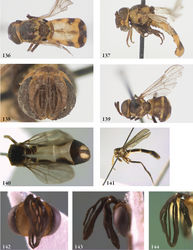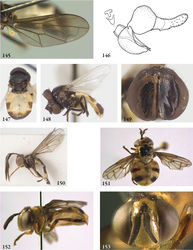Masarygus
| Notice: | This page is derived from the original publication listed below, whose author(s) should always be credited. Further contributors may edit and improve the content of this page and, consequently, need to be credited as well (see page history). Any assessment of factual correctness requires a careful review of the original article as well as of subsequent contributions.
If you are uncertain whether your planned contribution is correct or not, we suggest that you use the associated discussion page instead of editing the page directly. This page should be cited as follows (rationale):
Citation formats to copy and paste
BibTeX: @article{Reemer2013ZooKeys288, RIS/ Endnote: TY - JOUR Wikipedia/ Citizendium: <ref name="Reemer2013ZooKeys288">{{Citation See also the citation download page at the journal. |
Ordo: Diptera
Familia: Syrphidae
Name
Masarygus Brèthes – Wikispecies link – Pensoft Profile
- Masarygus Brèthes, 1909: 441. Type species: Masarygus planifrons Brèthes, 1909: 442, by original designation.
Description
Body length: 4–7 mm. Small, delicate flies with long antennae and flat abdomen. Head slightly to much wider than thorax. Face concave, either entirely or only laterally; wider than an eye. Mouth parts undeveloped: oral opening absent or hardly visible. Vertex more or less flat, not strongly produced or convex. Occiput ventrally narrow or widened, dorsally widened. Eye bare. Eyes in male not converging at level of frons, with mutual distance about 4 times the width of antennal fossa. Antennal fossa about as wide as high or about 1.5 times as wide as high. Antenna as long as or longer than distance between antennal fossa and anterior oral margin; basoflagellomere longer than scape, multifurcate in male (3 to 14 branches), unfurcate in female; bare; arista absent in male, present in female. Postpronotum bare. Scutellum semicircular; without calcars. Anepisternum convex; entirely with sparse, bristle-like pile. Anepimeron bare or pilose. Katepimeron convex; bare; with or without wrinkled texture. Wing: vein R4+5 without posterior appendix; vein M1 perpendicular to vein R4+5; postero-apical corner of cell r4+5 widely rounded or rectangular, with or without small appendix; crossvein r-m located very close to base of cell dm (within basal 1/10). Abdomen dorsoventrally flattened; more or less trapezoid, with lateral margins gradually widening posteriad, with largest width at tergite 4; 1.5-2.5 times as long as wide. Tergites 3 and 4 fused. Male genitalia: phallus furcate near apex, straight, projecting not or hardly beyond apex of hypandrium; epandrium without ventrolateral ridge; surstylus unfurcate, more or less oval.
Diagnosis
Vein R4+5 without posterior appendix. Postpronotum bare. Antenna at least as long as distance between antennal fossa and anterior oral margin. Antenna inserted on head above dorsal eye margin.
Discussion
Originally, this genus was erected as the first known member of a new family, the Masarygidae (Brèthes 1908[1]; but journal publication was 1909, see Sabrosky 1999[2]). Brèthes associated it with Conopidae and Scenopinidae because of the wing venation, and with Oestridae because of the reduced mouthparts. He also noted a superficial resemblance to certain Stratiomyidae. Bezzi (1910)[3] was the first to recognize Masarygus as belonging to the Syrphidae and related to Microdon, by pointing out its resemblance to Ceratophya and the apparent relationship with ants (as noted by Brèthes 1908[1]). Shannon (1925)[4] considered Masarygus as a synonym of Microdon. Brèthes (1928)[5] objected by pointing out that Masarygus differs from Microdon in the distinct sexual dimorphism and also in wing venation. All subsequent authors have included Masarygus in the Microdontinae.
Masarygus was the first described syrphid taxon with a furcate basoflagellomere (in the male sex only). A few other taxa with this character were described during the 20th century: Schizoceratomyia Carrera, Lopes & Lane, 1947, Johnsoniodon Curran, 1947 and Carreramyia Doesburg, 1966. Masarygus, Schizoceratromyia and Johnsoniodon were considered synonymous by Hull (1949)[6], who also regarded “Masarygus as a Rhoga with fissicorn antennae”, without explicitly including all of these taxa in Rhoga (the oldest name). Papavero (1962)[7] also considered Masarygus, Schizoceratomyia and Johnsoniodon synonymous, because he found that the number of branches on the basoflagellomere (four in Masarygus planifrons, two in the other taxa) was a species-level character rather than a generic character. Van Doesburg (1966)[8] did not agree and considered Masarygus and Schizoceratomyia (including Johnsoniodon) as distinct genera, because of distinct differences in shape of head, antenna and abdomen. Thompson et al. (1976)[9] followed the opinion of Papavero (1962)[7]. Cheng and Thompson (2008)[10] considered Masarygus and Schizoceratomyia as distinct groups.
Masarygus palmipalpus sp. n. is considered related to Masarygus planifrons because of the following shared characters: male basoflagellomere multifurcate; base of antenna in lateral view placed above dorsal eye margin; head strongly flattened; face concave; oral opening absent; abdomen dorsoventrally flattened; gradually widening hindward, with widest point at tergite 4; phallus furcate near apex, with both processes equally long.
In addition to Masarygus planifrons and Masarygus palmipalpus, two undescribed species are considered to belong to this genus. These species are included in the phylogenetic analyses of Reemer and Ståhls (in press)[11] under the names Masarygus sp. 1 and sp. 2. The latter has three branches on the basoflagellomere, the first approximately 14. Whereas sp. 1 is placed in the same clade as Masarygus planifrons and Masarygus palmipalpus by Reemer and Ståhls (in press)[11] (based on adult morphology), sp. 2 is placed in the clade containing Schizoceratomyia and Carreramyia. Species 2 is nevertheless included in Masarygus, because of the following characters: basoflagellomere multifurcate and bare (instead of bifurcate and pilose as in Schizoceratomyia); arista absent (present in Schizoceratomyia); base of antenna inserted on head above dorsal eye margin (not below as in Schizoceratomyia); vertex not strongly produced (in contrast with Carreramyia); crossvein r-m located within basal 1/10 of cell dm (between basal 1/4 and 1/8 in Schizoceratomyia); hind tibia not swollen and without long, brush-like pile (in contrast with Carreramyia). Unfortunately, the genitalia of the only known specimen of Masarygus species 2 are lost: there is a microvial containing postabdominal segments attached to the pin, but there are no genitalia in it.
Diversity and distribution
Described species: 2. Neotropical. At least two undescribed species are known to occur (see Discussion). All species known so far, including the undescribed ones, have only been collected on one occasion.
Taxon Treatment
- Reemer, M; Ståhls, G; 2013: Generic revision and species classification of the Microdontinae (Diptera, Syrphidae) ZooKeys, 288: 1-213. doi
Other References
- ↑ 1.0 1.1 Brèthes J (1908) Masarygidae. Una nueva familia de dípteros. Anales del Museo Nacional de Buenos Aires 10, 3rd series: 439–443. [published in 1909]
- ↑ Sabrosky C (1999) Family-group names in Diptera. Myia 10: 1-576.
- ↑ Bezzi M (1910) Zur Synonymie und systematischen Stellung einiger Dipteren. Societas Entomologica 25: 65-67.
- ↑ Shannon R (1925) An extraordinary adult myrmecophile from Panama. Proceedings of the National Academy of Sciences 10: 211-213.
- ↑ Brèthes J (1928) A propósito de Masarygus Brèthes y de Sarcophaga Caridei Brèthes. Revista de la Sociedad Entomológica Argentina 7: 73-74.
- ↑ Hull F (1949) The morphology and inter-relationships of the genera of syrphid flies, recent and fossil. Transactions of the Zoological Society 26: 257-408. doi: 10.1111/j.1096-3642.1949.tb00224.x
- ↑ 7.0 7.1 Papavero N (1962) Quatro novas espécies de Microdontinae do Brasil (Diptera, Syrphidae). Papéis Avulsos do Departamento de Zoologia 15: 317-326.
- ↑ van Doesburg S (1966) Syrphidae from Suriname. Additional records and descriptions. Studies on the Fauna of Suriname and other Guyanas 9: 61-107.
- ↑ Thompson F, Vockeroth J, Sedman Y (1976) Family Syrphidae. A catalogue of the Diptera of the Americas south of the United States 46: 1-195.
- ↑ Cheng X, Thompson F (2008) A generic conspectus of the Microdontinae (Diptera: Syrphidae) with the description of two new genera from Africa and China. Zootaxa 1879: 21-48.
- ↑ 11.0 11.1 Reemer M, Ståhls G (in press) Phylogenetic relationships of Microdontinae (Diptera: Syrphidae) based on parsimony analyses of combined molecular and morphological characters. Systematic Entomology 38.
Images
|

